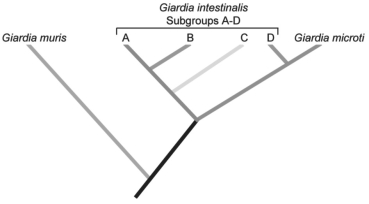
Figure 29.1
Use the following information to answer the corresponding question(s) .
Giardia intestinalis can cause disease in several different mammalian species,including humans.Giardia organisms (G.intestinalis) that infect humans are similar morphologically to those that infect other mammals;thus they have been considered a single species,though other species in the Giardia genus infect other organisms.However,G.intestinalis has been divided into different subgroups based on their host and a few other characteristics.
In 1999,a DNA sequence comparison study tested the hypothesis that these subgroups actually constitute different species.The following phylogenetic tree was constructed from the sequence comparison of rRNA from several subgroups of G.intestinalis and a few other morphologically distinct species of Giardia.The researchers concluded that the subgroups of Giardia are sufficiently different from one another genetically that they could be considered different species.

-By examining the phylogenetic tree diagrammed in Figure 29.1,what conclusion can you draw about the species G.microti?
A) It evolved before G.intestinalis.
B) It is more closely related to G.muris than to G.intestinalis.
C) It should not be labeled a species distinct from G.intestinalis.
D) It is part of a monophyletic group that also includes G.intestinalis.
Correct Answer:
Verified
Q5: Which of the following statements best describes
Q5: You discover a new eukaryotic species.It is
Q6: When a mosquito infected with Plasmodium first
Q6: Which of the following eukaryotic lineages contains
Q8: Which of the following is most likely
Q9: Imagine there are 25 different species of
Unlock this Answer For Free Now!
View this answer and more for free by performing one of the following actions

Scan the QR code to install the App and get 2 free unlocks

Unlock quizzes for free by uploading documents